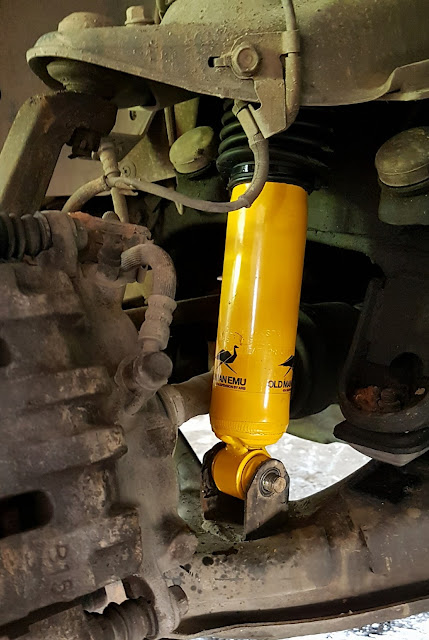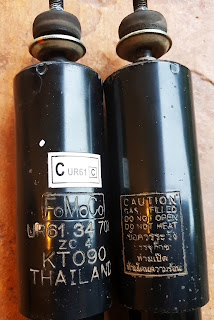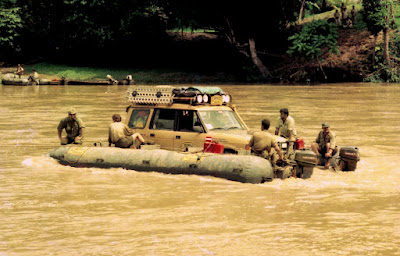‘Just down the road’ – a journey of self-discovery
A story 40 years in the making, parts of which have been told before but never written down in its entirety.
On January 2, 1983, I set off to hitchhike from Perth to Melbourne. I remember the date clearly because we had a big party at 29, Bruce Street, Nedlands, on December 31, 1982, to usher in the New Year, and since every guest brought extra booze, we had so much left over that we had to have a finish-the-booze party on New Year’s day.
Suitably prepped and inspired, I asked a friend, Bob Uzaraga, for a lift from my home in Nedlands to Armadale, the last suburb before the highway south began. He obliged and asked with concern, “Are you sure about this?” as he dropped me off by the roadside. (I am still not sure if he was more concerned about my well-being or his Walkman that I had borrowed for the trek ![]() )
)
I had a destination in mind, but no real plan. There were some former classmates from Kuching who were then in Melbourne so I would look them up and bunk with them. That was it.
I had AUD50, a rough idea it was about 3,000km away, I had their addresses from exchanging letters over the past couple of years. Worries? We worry about the things we know of, the dangers and pitfalls that lie in wait. I knew little, so had even less to worry about. So, as the Aussies say, “She’ll be right, mate!”
The first stretch of the trek was southward on the Albany Highway, which I had been on a few times before on trips to the popular southern seaside town of Albany. After an hour or so of sticking out my right index finger (the Aussie way, as opposed to the better-known American thumb), the first car stopped and gave me a ride and I was on my way.
Within minutes, we passed another car being pulled over by an unmarked police patrol. “He was flashing his headlights at oncoming traffic to warn them about the cops,” my host explained. Ah, so, I was learning something new already.
I was dropped off at Arthur River and waited a couple of hours for a ride eastwards in the direction of Ravensthorpe and, eventually, Esperance.
Heading east was exciting as this direction would eventually lead to the Eastern States! But it was still a long way off, and I had to spend a couple of nights by the roadside with just a sleeping bag. It was the southern summer so chance of rain was slim to none.
Aussie country towns can be separated by a hundred or several hundreds of kilometres but locals will always tell you it is ”just down the road”. So, getting to your desired destination is a matter of stringing together a series of “just down the road” parts.
A farm truck with bales of hay on the back, a Holden panel van, and a Ford Fairmont sedan driven by two elderly ladies, one of whom had pink hair, conveyed me eastward to Ravensthorpe, and then south-eastward to Esperance. Pink came up again when the ladies pointed out the pink lake that was an attraction near Esperance.
I booked into a caravan park in town even though I had no caravan, and not even a tent, simply because I had stayed at a caravan park before. For $10, I had a patch of grass for the night, and befriended the grandfather-and-grandson combination in the next lot. They were better equipped, having their car and tent, having driven all the way from Melbourne on their epic East-West bonding road trip.
Resuming the trip next morning at the edge of town, I met up with some fellow hitch-hikers and compared notes. Turned out they had chosen the much better option of a travellers’ hostel in Esperance where they had a bed in a dorm for just $5 each! I didn’t know that!
To continue to the East, I now had to go northward first, to Norseman, the last town before a 90-degree right turn takes travellers onto the Nullarbor. It was somewhere along this stretch that I learned that what I had been told about Nullarbor being an Aboriginal word was wrong and that it was, in fact, Latin. “Null” for no or none, and “Arbor” for trees. Learning never stops, and that was what I was learning, every day.
When hitch-hiking, you don’t actually get to go exactly where you wish to go to, you get to go wherever the driver kind enough to give you a lift happens to be headed, which was how I ended up spending a night in the quaintly-named town of Grass Patch.
“Head for the hotel” upon reaching a country town was the wisdom I had picked up by this time. Except in this case, the “hotel” meant the local pub, and town sizes were measured by how many hotels/pubs they had.
Grass Patch seemed to be a one-hotel town in the heart of wheat country, and I walked into it hoping to meet friendly locals but was greeted only by cold stares. This was a long way from cosmopolitan Perth, and in the early 1980s, the country boys did not often see Asian faces. They that had were thinking “Japanese”, and memories were still fresh of World War 2.
Awkward. I looked around frantically for an ice-breaker, and found it in WW2. There, on the wall behind the bar counter, was a framed certificate testifying that Tom Starcevic of Grass Patch, Western Australia, had been awarded the Victoria Cross for gallantry in the face of the enemy in Borneo.
“Is Mr Star … Starse . Starcevic … still alive?” I asked. Pronouncing the name was difficult, and I learned only much later that it was of Croatian origin. Had never heard of Croatia at that point in time.
“Yeah, old Tom’s around. What’s it to you?” was the less-than-friendly response to this unwelcome intruder, probably mistaken for a Japanese.
“Oh, nothing much, it’s just that I’m from Borneo,” I replied, trying to salvage the tense situation.
And, just like that, as if someone had flicked a switch, the atmosphere was transformed.
“He’s from Borneo!” the barman announced to the entire room, and then everyone was smiling, grinning, coming over to shake my hand and buying me beers!
After the warm welcome, someone asked where I was putting up for the night. “Would appreciate if you could point me to some comfortable spot by the road,” I replied.
“No, mate, you’re coming home with me!” he said.
And as we got near to his front door, he whispered “I have a confession to make, I have an ulterior motive for inviting you home.”
Oh no! Was this what all those warnings about the dangers of hitch-hiking was about! Thoughts flashed through my mind.
He continued: “I wasn’t supposed to be at the pub, it’s the missus’s birthday, you see. So I figured, if I brought a guest home …”
And so, I ended up as a guest, drinking Madeira wine at a family’s birthday party in Grass Patch, W.A.! Sadly, I cannot remember his name now after 40 years, but I do recall the wife’s family was descended from Alexander Forrest, a renowned Australian explorer who has a place in Perth named after him, Forrest Place, off Wellington Street.
My host drove a grader for the local council, and if anyone reading this knows the Grass Patch community well, please convey my regards and gratitude.
The next morning, they provided me with a chair and their daughters chatted with me as I resumed the attempt to catch a ride northward. This was the most comfortable way to hitch-hike, I learned.
A lorry picked me up and delivered me to Norseman after a relatively uneventful journey.
I went over to say hello to some fellow hitch-hikers sheltering under a tree and found out that there were from the Perth suburb of Leederville, where I had attended college a couple of years earlier, and that they were also trying to get to the East. (Photo is of that tree, viewed on Google Earth since I have not been back there since.)
My heart sank upon learning that they had been there a couple of days without getting a ride. Maybe it’s not such a great idea after all, maybe it’s just too hard. Self-doubt crept in.
But, having come this far, might as well try for a few hours, I thought. And if worse came to worse, I could head back west to Perth.
I observed that the other travellers were content to stay under the tree and stick a finger out whenever a car passed by, and it seemed no one would stop to give a lift.
Drawing on some recent experience in door-to-door encyclopaedia sales, I decided to try a more pro-active approach.
The tree was right next to a petrol station, the last one before heading into the Nullarbor. I walked over and started chatting with motorists fuelling up their cars. Most were locals who had no plan to drive to Melbourne or Sydney.
After a few hours, despair returned. This was not working, I was not going anywhere. But, “don’t give up, it’s a numbers game, you never know when success might be just around the corner”, was the other inner voice, speaking from the sales training and experience.
I chatted with a friendly couple with a young daughter aged about six years, and they were driving to Adelaide. But their little Holden Gemini seemed tiny so they were unlikely to give me a lift and so, I did not ask.
We said our goodbyes and they drove off. After going about 50 metres, the Gemini stopped and then reversed back to where I was still standing and his head popped out to ask: “Would you like a lift?”
And that was the moment “don’t give up, it’s a numbers game, you never know when success might be just around the corner” became real. I had, in fact, given up on that one chance, but was given an undeserved second chance.
Nullarbor, here I come! It was a long journey, very, very long, a perfectly straight across a largely featureless plain. The family stopped for the night at a motel somewhere in the middle, and I slept outdoors in my sleeping bag, re-joining them in the morning to resume the journey.
This stretch of the journey was when the Sony Walkman I’d borrowed from Bob and a solitary cassette, “Greatest Hits of The Eagles” kept me entertained and ingrained forever in my mind that theirs was my kind of road trip music, which remains to this day.
After many hours, we finally reached Eucla and then crossed the state border into South Australia and stopped for the night at Port Augusta where the family checked into a caravan park.
“Goodbye, thanks for everything and if you see me by the roadside tomorrow, please give me a lift,” was my parting words with this kind family.
Spotting a local about my age walking past, I asked: “Mate, could you tell me the way to the nearest pub?”
“You’ve found the right person, follow me!” he replied.
We became friends and he introduced me to more of his friends, one of whom was Boof, a six-foot-six mountain of a giant who was serving in the Royal Australian Navy.
“Oh, you’re heading to Melbourne? I’m going there in the morning,” Boof said at some point.
And that was how I got my next lift, on Boof’s Yamaha XS1100. Yes, a motorcycle. At a time when I was really, really into motorcycles, especially the big ones with litre-plus engines.
Boof even found a helmet and jacket that fitted my relatively tiny size, and we headed off for a two-day ride. We had to camp for a night somewhere near the South Australia-Victoria where there was brief drama when the first spot he chose to lay his sleeping bag turned out to be occupied by angry bull ants who objected to sharing with us.
After a total of eight days and seven nights, I was dropped off at a street corner about 200 metres from where my classmate Chin Khoon Ho was staying. I made my way there, knocked on the door and introduced myself to his surprised brother, Khoon Yong, who answered.
Khoon Ho was out at the time and when he returned, he said “Hi” to me and walked on by. After turning a corner, his head reappeared around the corner and he said: “Is that you? What are you doing here?” Surprise had been achieved.
It was only later I found out how lucky I had been, and how things could have turned out differently, in a bad way.
It had not occurred to me that, since I was on the year-end semester break, all my friends were also on holiday and might not be around. Also, students moved houses a lot, so many of the addresses I had cleverly compiled were, in fact, outdated.
The day I arrived was the last day that Khoon Ho was at that address, and I help him carry stuff as they moved out that very afternoon. If I had arrived another day, or even hours later, it would have been disastrous for me.
There were more adventures as I explored Melbourne, took a train to Sydney and returned by coach to Melbourne, caught by with the grandson from the Esperance caravan park who brought me for my first and only, ever, experience of surfing, passed through the picturesque Adelaide hills on the homeward coach journey just a couple of weeks before the calamitous Ash Wednesday fires of 1983. But guess that’ll be for another time.
p.s. I have to rely on modern technology from Google to supplement my ancient memory. The hitch-hike from Armadale to Melbourne was 3,500km, give or take, and would have been a 37-hour drive at constant speed.











































